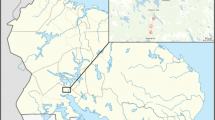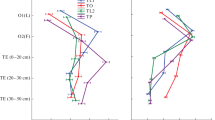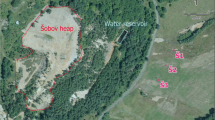Abstract
Isolations of soil microfungi from the humus (F/H-layer) of a coniferous forest soil which was either unpolluted (pH 4.1) or polluted (pH 6.6) for 25 years by deposition of alkaline dust, were made by soil washing and spore plating. Both techniques revealed similar changes in species composition. Alkaline dust exposure caused a reduction in overall species numbers, but led to higher relative isolation frequencies of Mortierella alpina, Oidiodendron tenuissimum, Penicillium montanese, Sagenomella verticillata, and Trichosporiella sporotrichioides. The incidence of M. isabellina, O. cf. clamydosporium, P. spinulosum, Penicillium sp. 1, P. sclerotiorum, Trichoderma viride, and Verticillium bulbillosum was reduced on polluted sites. The amount of the mainly fungal-derived phospholipid fatty acid 18 : 2ω6 decreased by 23%, while the amount of ergosterol increased by 9% in the polluted soil.
Similar content being viewed by others
References
Arnebrant K, Bååth E, Söderström B (1990) Changes in microfungal community structure after fertilization of Scots pine forest soil with ammonium or urea. Soil Biol Biochem 22:309–312
Bååth E (1981) Microfungi in a clear-cut pine forest soil in central Sweden. Can J Bot 59:1331–1337
Bååth E (1988) A critical examination of the soil washing technique with special reference to the effect of the size of the soil particle. Can J Bot 66:1556–1569
Bååth E (1989) Effects of heavy metals in soil on microbial processes and populations (a review). Water Air Soil Poll 47:335–379
Bååth E, Lundgren B, Söderström B (1984) Fungal populations in podzolic soil experimentally acidified to simulate acid rain. Microb Ecol 10:197–203
Bewley RJF, Parkinson D (1985) Bacterial and fungal activity in sulphur dioxide polluted soils. Can J Microbiol 31:13–15
Bissett J, Parkinson D (1979) The distribution of fungi in some alpine soils. Can J Bot 57:1609–1629
Bligh EG, Dyer WJ (1959) A rapid method of total lipid extraction and purification. Can J Biochem Physiol 37:911–917
Domsch KH, Gams W, Anderson T-H (1980) Compendium of soil fungi. Academic Press, London.
Duxbury T (1985) Ecological aspects of heavy metal responses in microorganisms. In: Marshall KC (ed) Advances in microbial ecology, vol. 8. Plenum Press, New York, pp 185–236
Fritze H (1991) Forest soil microbial response to emissions from an iron and steel smelter. Soil Biol Biochem 23:151–155
Fritze H, Kiikkilä O, Pasanen J, Pietikäinen J (1992) Reaction of forest soil microflora to environmental stress along a moderate pollution gradient next to an oil refinery. Plant Soil 140:175–182
Frostegård Å, Tunlid A, Bååth E (1991) Microbial biomass measured as total lipid phosphate in soils of different organic content. J Microbiol Methods 14:151–163
Gams W, Söderström B (1983) Oidiodendron scytaloides n. sp. Cryptog Mycol 4:239–243
Grant WD, West AW (1986) Measurement of ergosterol, diaminopimelic acid and glucosamine in soil: Evaluation as indicators of microbial biomass. J Microbiol Methods 6:47–53
Holdenrieder O, Sieber TN (1992) Fungal associations of serially washed healthy non-mycorrhizal roots of Picea abies. Mycol Res 96:151–156
Ivarson KC (1977) Changes in decomposition rate, microbial population, and carbohydrate content of an acid peat bog after liming and reclamation. Can J Soil Sci 57:129–137
Kvalheim OM, Karstang TV (1987) A general-purpose program for multivariate data analysis. Chemom Intell Lab Sys 2:235–237
Parkinson D, Williams ST (1961) A method for isolating fungi from soil microhabitats. Plant Soil 13:347–355
Saranpää P, Nyberg H (1987) Lipids and sterols of Pinus sylvestris L. sapwood and heartwood. Trees 1:82–87
Söderström B, Bååth E (1978) Soil microfungi in three Swedish coniferous soils. Holarct Ecol 1:62–72
Tunlid A, White DC (1992) Biochemical analysis of biomass, community structure, nutritional status, and metabolic activity of microbial communities in soil. In: Stotzky G, Bollag J-M (eds) Soil Biochemistry, vol. 7. Marcel Dekker, New York, pp 229–262
Visser S, Parkinson D (1989) Microbial respiration and biomass in soil of a lodgepole pine stand acidified with elemental sulphur. Can J For Res 19:955–961
Author information
Authors and Affiliations
Additional information
Offprint requests to: H. Fritze.
Rights and permissions
About this article
Cite this article
Fritze, H., Bååth, E. Microfungal species composition and fungal biomass in a coniferous forest soil polluted by alkaline deposition. Microb Ecol 25, 83–92 (1993). https://doi.org/10.1007/BF00182131
Received:
Revised:
Issue Date:
DOI: https://doi.org/10.1007/BF00182131




